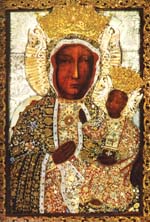Jasna Gora Sanctuary in Czestochowa
It is the holiest place of Poland and one
of the world’s most important destinations for pilgrims. The
Jasna Gora (Bright Mount in Polish) sanctuary in
Czestochowa, industrial city of 300,000 a ninety minutes’
drive northwest from
Krakow, has been Central Europe’s spiritual hub
for six centuries and it shows.
Every year several million pilgrims – commoners as well as
celebrities – come here to pray before the miraculous
picture of Our Lady of Czestochowa. The faithful has
believed for ages that St. Luke the Evangelist himself
painted the divine icon on a tabletop from the Holy Family’s
house. Anyway, over the last half-millennium great number of
them have had their prayers heard and, grateful, left
innumerable votive offerings displayed in the sanctuary.
Sightseeing in the sanctuary of Jasna Gora
Small 15th-century Gothic chapel with Our Lady of
Czestochowa’s holy picture, also known as 'The Black
Madonna', is the heart of the sanctuary. It adjoins vast
Baroque church of 1695. The fine 105-meter-tall tower
crowned with viewing gallery dates back to 1620. The
adjacent mid-17th-century early-Baroque monastery contains
the Great Refectory of 1644, the Knight Hall of 1647, and
the 18th-century library with unmatched collection of old
books. Fortifications date from 1643 while majestic gates
are a century younger.
The monastery’s treasure-house is a must by virtue of the
artistic and/or historical value of its collections. The arsenal
and the museum of the sanctuary’s 600th anniversary are also
worthwhile.
With the average of 14,000 visitors a day the sanctuary seems
often crowded, yet the feast days of May 3, August 15 and
September 8 gather real multitudes from all over the world.
Our Lady of Czestochowa’s icon
Tradition has it that St. Luke the Evangelist painted two
pictures of the Virgin Mary on a tabletop once used by the Holy
Family. One icon eventually made to Italy’s Bologna. Emperor
Constantine brought the other from Jerusalem to Constantinople,
and some 600 years later it was awarded to Prince Lev of Rus for
his military services. In the 14th century a Polish prince,
Wladislaw of Opole, found the icon in the Belz castle while he
was warring Tatars who had conquered neighboring Rus, and he
entrusted the holy image to the Pauline monks in Czestochowa. So
says the 1474 volume of Translatio Tabulae
from the Jasna Gora library. April 14, 1430, on the Easter,
Bohemian robbers looted the Jasna Gora monastery, slashed Our
Lady’s cheek with swords, and – by the account of the 1523 "Historia
Pulchra" – left the holy image on the floor, broken in
three.
Art historians believe Our Lady of Czestochowa was initially a
Byzantine icon of the Hodigitria
type, dated from the 6th to 9th centuries. During the
15th-centrury restoration in Krakow it was painted anew because
the restorers were not able to apply their tempera colors over
the original wax paint so they scraped it clean.
History of the Czestochowa sanctuary in brief
1220: the earliest mention of "Czestochowa" in writing.
1356: King Casimir the Great gave Czestochowa municipal
autonomy.
1384: Prince Wladyslaw of Opole supplied the Jasna Gora
monastery he had founded with the miraculous picture of the Holy
Virgin.
1404: King Wladyslaw Jagiello’s pilgrimage to Jasna Gora.
1430: Bohemian robbers raided the monastery and smashed the
Black Madonna’s icon.
1655: despite a fierce and prolonged siege fortified Jasna Gora
monastery occurred the only stronghold in Poland Swedish
invaders failed to capture, which proved a turning point in the
devastating war.
1717: coronation of Our Lady of Czestochowa’s picture.
1770-1772: Jasna Gora was a fortress of anti-Russian Bar
Confederation insurgents led by Kazimierz Pulaski, future
American hero.
1846: opening of the Warsaw-Vienna railroad line through
Czestochowa enabled the city’s rapid industrialization.
1979: John Paul II visited Jasna Gora for the first time as the
pope.
Travel to Czestochowa from Krakow.
Every day a couple of trains leave Krakow Glowny central
rail station for Czestochowa. There is also regular bus
service between Krakow and Czestochowa with coaches leaving
the RDA central bus depot several times a day.
|


Our Lady of Czestochowa, a.k.a. "The Black Madonna",
is Poland's holiest icon.
In the proximity
of Krakow
Krakow is Poland's tourist mecca, and also a gateway to
many other must-see sites in the region.
Malopolska
Province
Poland map
City of Krakow map
Krakow
Poland's prime tourist attraction and a must in Central
Europe boasts numerous world-class monuments, charming vistas,
delightful atmosphere, and the best restaurants.
Krakow's Skalka
Sanctuary
Poland’s second holiest shrine at the site of St.
Stanislav’s 1079 martyrdom. Splendid Baroque church and fine
monastery modeled on a Renaissance castle.
Kalwaria
With its 42 Baroque churches and chapels of all shapes
and sizes in addition to the central basilica and the Franciscan
monastery, the Kalwaria Zebrzydowska sanctuary is Europe's
biggest Calvary shrine.
Sanctuary of the
Lord's Mercy
Humble nun’s visions in the 1930s gave rise to a
world-wide spiritual movement inside the Catholic Church, ever
stronger nowadays, with the center in her Krakow convent
In the footsteps
of Pope John Paul II
|



